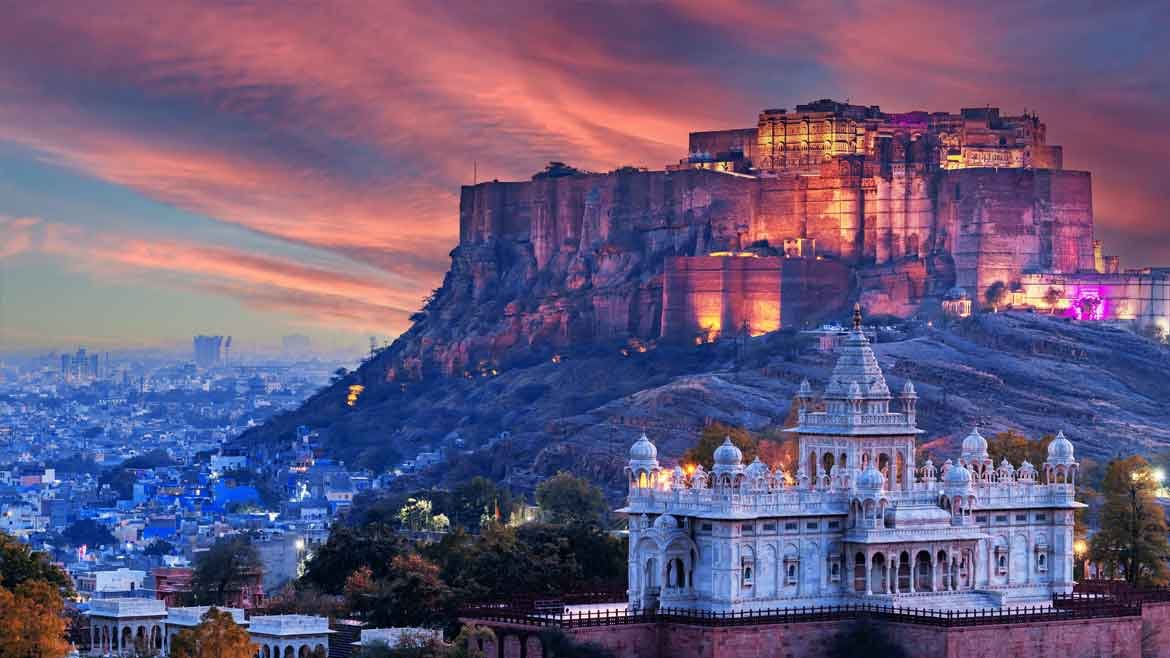Mehrangarh Fort
Mehrangarh Fort
Exploring the Majestic Mehrangarh Fort and Enchanting Jaswant Thada in Jodhpur
INTRODUCTION
Welcome to my travel blog, where I share the captivating experiences of my journeys. Today, I take you on a mesmerizing tour of Mehrangarh Fort, a symbol of grandeur and history in Jodhpur, Rajasthan. Perched on a high hill, this formidable fort offers panoramic views of the blue city below. Additionally, we will discover the enchanting Jaswant Thada, a white-marbled mausoleum often called the “Taj Mahal of Mewar.” Let’s delve into the architectural brilliance and rich heritage of these iconic monuments.
MEHRANGARH FORT – A JEWEL OF RAJASTHAN
Mehrangarh Fort stands proudly as one of Rajasthan’s most splendid forts, built by Rao Jodha in 1459. Its massive structure spans 5 km atop a 125 m high hill overlooking Jodhpur. The fort boasts seven majestic gates, each commemorating triumphs over Bikaner and Jaipur armies
Once inside, you’ll be awestruck by the intricate palaces within, such as Moti Mahal, Phool Mahal, Sheesh Mahal, and others. The fort also houses two temples, Chamundi Devi Mandir and Nagnechiaji Mandir, dedicated to Goddess Durga and the Kuldevi, respectively.
A treasure trove of history awaits at the fort’s museum, showcasing a diverse collection of palanquins, musical instruments, royal cradles, costumes, arms, furniture, and paintings. Mehrangarh Fort narrates the stories of bygone rulers and their contributions to its timeless grandeur.
LEGENDS AND ARCHITECTURE
The fort’s history is steeped in legends, with Rao Jodha shifting his capital to this elevated location, Bhakurcheeria, and founding Mehrangarh Fort. The tale of appeasing the hermit Cheeria Nathji and the construction of a temple for him within the fort adds an intriguing twist to its origin.
Mehrangarh’s architecture is a remarkable blend of styles spanning five centuries. Its expansive walls, rising up to 120 feet in places, stand as a testament to its formidable nature. The seven gates and exquisitely decorated palaces reflect the artistic brilliance of various eras.
MEHRANGARH FORT TODAY
Today, Mehrangarh Fort remains a captivating destination for visitors. The grand museum, cultural performances, and Chokelao Bagh, a restored 18th-century garden, make the experience unforgettable. For thrill-seekers, zip-lining offers a unique adventure against the backdrop of the magnificent fort.
The fort hosts prestigious events like the Rajasthan International Folk Festival and the World Sufi Spirit Festival, celebrating the region’s rich cultural heritage. As the custodian, Maharaja Gaj Singh II continues to uphold the legacy of Mehrangarh with pride.
JASWANT THADA – A MARBLE MARVEL
Nestled amidst lush greenery and overlooking a serene lakeside, Jaswant Thada, known as the Taj Mahal of Mewar, stands as another architectural gem of Jodhpur. This white-marbled mausoleum was erected in the 19th century by Maharaja Sardar Singh in memory of his father, Maharaja Jaswant Singh II.
The temple-like architecture and finely carved exteriors emit a warm glow under sunlight, making it a visual delight. Today, Jaswant Thada is open to the public, managed by the Mehrangarh Museum Trust. Inside, visitors can explore exquisite paintings and portraits of Jodhpur rulers, offering glimpses into the region’s history.
CONCLUSION
As we conclude this virtual journey, I hope you’re inspired to visit Mehrangarh Fort and Jaswant Thada in person. Embrace the splendor of Rajasthan’s architecture and immerse yourself in the rich heritage of Jodhpur. Join me on my next adventure as we uncover more remarkable destinations around the world. Until then, happy exploring!
PRACTICAL INFORMATION FOR TRAVELERS
- Nearest Airport: Jodhpur Airport (JDH) – Approx. 6 km from Mehrangarh Fort
- Nearest Railway Station: Jodhpur Junction Railway Station – Approx. 5 km from Mehrangarh Fort
- Weather: Best time to visit is from October to March when the weather is pleasant.



